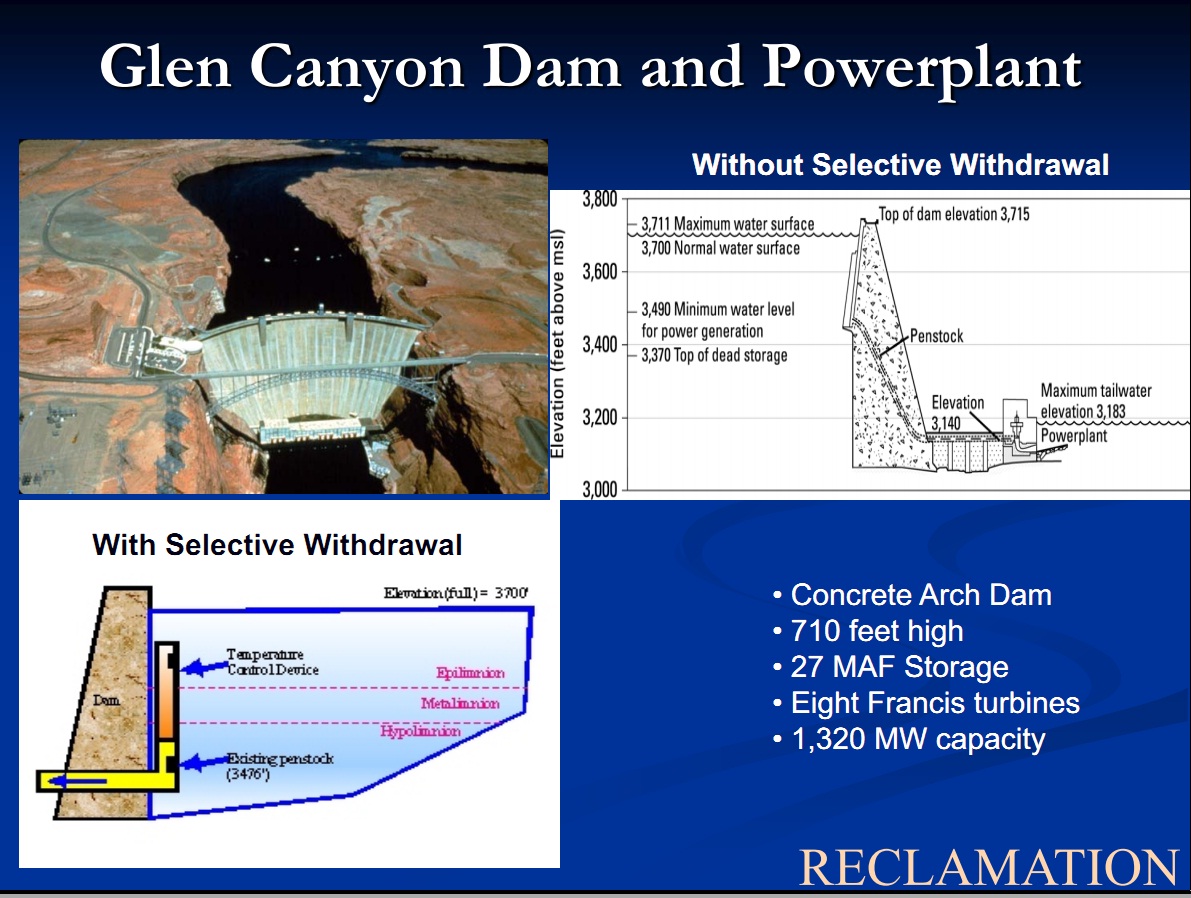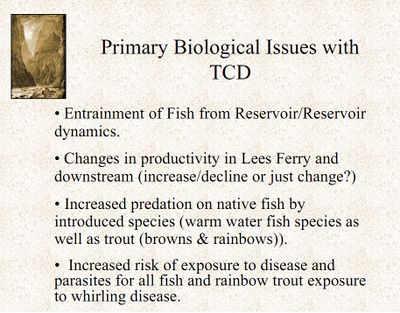Difference between revisions of "TCD Learning Page"
Cellsworth (Talk | contribs) |
Cellsworth (Talk | contribs) |
||
| (2 intermediate revisions by the same user not shown) | |||
| Line 59: | Line 59: | ||
=='''Thermal Curtain'''== | =='''Thermal Curtain'''== | ||
| − | Examples: Whiskeytown Reservoir, Lewiston Reservoir | + | Examples: Whiskeytown Reservoir, Lewiston Reservoir, Burrendong Dam. |
A thermal curtain is a type of selective withdrawal structure that can be installed on existing facilities without interrupting operations. Depending on how a thermal curtain is configured, they can be used to either increase or decrease release temperatures. The thermal curtain is constructed of a non-permeable material that is installed in the forebay of a reservoir. If cooler release temperatures are desired, the thermal curtain is configured to extend from the water’s surface down to the thermocline. This blocks the warmer, surface water from entering the dam’s intakes and being released downstream. If warmer release temperatures are desired, the thermal curtain is configured to extend from the thermocline down to the bottom of the reservoir. This blocks the colder, sub-surface water from entering the dam’s intakes and being released downstream. Thermal curtains can also be configured to cool water temperatures in the dam’s forebay to create a behavioral barrier to warmwater fish entrainment through the dam. Behavioral barriers are generally considered more effective than mechanical barriers (i.e. screens, nets, electrical fields, etc.) in reducing fish entrainment. Thermal curtains have been successfully deployed in both warm-water and cold-water configurations. Initial modeling has suggested a thermal curtain installed at Glen Canyon Dam could reduce water temperatures in the forebay and lower release temperatures enough to reach downstream temperature targets without the need of bypass. This potentially resolves issues associated with reduced hydropower generation and impacts to the Basin Fund, which is needed to fund the operations and maintenance of the CRSP system, while also reducing warm-water fish entrainment and providing increased control of release temperatures to meet downstream biological goals. | A thermal curtain is a type of selective withdrawal structure that can be installed on existing facilities without interrupting operations. Depending on how a thermal curtain is configured, they can be used to either increase or decrease release temperatures. The thermal curtain is constructed of a non-permeable material that is installed in the forebay of a reservoir. If cooler release temperatures are desired, the thermal curtain is configured to extend from the water’s surface down to the thermocline. This blocks the warmer, surface water from entering the dam’s intakes and being released downstream. If warmer release temperatures are desired, the thermal curtain is configured to extend from the thermocline down to the bottom of the reservoir. This blocks the colder, sub-surface water from entering the dam’s intakes and being released downstream. Thermal curtains can also be configured to cool water temperatures in the dam’s forebay to create a behavioral barrier to warmwater fish entrainment through the dam. Behavioral barriers are generally considered more effective than mechanical barriers (i.e. screens, nets, electrical fields, etc.) in reducing fish entrainment. Thermal curtains have been successfully deployed in both warm-water and cold-water configurations. Initial modeling has suggested a thermal curtain installed at Glen Canyon Dam could reduce water temperatures in the forebay and lower release temperatures enough to reach downstream temperature targets without the need of bypass. This potentially resolves issues associated with reduced hydropower generation and impacts to the Basin Fund, which is needed to fund the operations and maintenance of the CRSP system, while also reducing warm-water fish entrainment and providing increased control of release temperatures to meet downstream biological goals. | ||
| + | |||
| + | [[Image:Thermal Curtain coldwater.png|thumb|center|400px|]] | ||
| + | |||
| + | [[Image:Thermal Curtain warmwater.png|thumb|center|400px|]] | ||
=='''Selective Withdrawal Structure ''' == | =='''Selective Withdrawal Structure ''' == | ||
| − | Examples: Flaming Gorge Dam, | + | Examples: Shasta Dam, Folsom Dam, Jordanelle Dam, Flaming Gorge Dam, Hungry Horse Dam, Cougar Dam, Applegate Lake. |
| + | |||
| + | A selective temperature withdrawal system is a rigid steel structures on the upstream face of the dam to enclose the penstock intakes (Svoboda 2020). Selective temperature withdrawal systems can be new external-frame structures that are attached to the dam or retrofit modifications to existing dam features, such as adding gates to the trash rack structure around the penstock intakes (Svoboda 2020). A previous selective temperature withdrawal system has been considered for the Glen Canyon Dam in the early 2007-2008 (Vermeyen 2011). Earlier proposals for the selective temperature withdrawal system were focused on warming downstream releases but the design was never finished. | ||
| + | |||
| + | [[Image:HungryHorseTCD.png|thumb|center|400px|]] | ||
| − | + | [[Image:GlenCanyonTCD.png|thumb|center|400px|]] | |
=='''Destratification: (Bubblers, Pumps, etc.)'''== | =='''Destratification: (Bubblers, Pumps, etc.)'''== | ||
| Line 83: | Line 91: | ||
The SEIS estimated an average hydropower impact from the Cool Mix alternative of $61.73 million (226.29 GWh) over a 45-month period (tables 3-12 and 3-17 in Bureau of Reclamation, 2024). Bypassed water does not produce hydropower and replacement costs are estimated to be ~$1 to $2 million per week (WAPA 2024, personal communication). Observed costs are tracking estimates presented in the SEIS. | The SEIS estimated an average hydropower impact from the Cool Mix alternative of $61.73 million (226.29 GWh) over a 45-month period (tables 3-12 and 3-17 in Bureau of Reclamation, 2024). Bypassed water does not produce hydropower and replacement costs are estimated to be ~$1 to $2 million per week (WAPA 2024, personal communication). Observed costs are tracking estimates presented in the SEIS. | ||
| − | |||
| − | |||
| − | |||
| − | |||
| − | |||
| − | |||
| − | |||
| − | |||
| − | |||
| − | |||
| − | |||
| − | |||
| − | |||
| − | |||
| − | |||
| − | |||
| − | |||
|} | |} | ||
| Line 181: | Line 172: | ||
*2027: Construction and installation | *2027: Construction and installation | ||
*2028-2031: Post construction monitoring | *2028-2031: Post construction monitoring | ||
| + | |||
| + | |- | ||
| + | ! <h2 style="margin:0; background:#cedff2; font-size:120%; font-weight:bold; border:1px solid #a3b0bf; text-align:left; color:#000; padding:0.2em 0.4em;"> 1999 TCD Effort </h2> | ||
| + | |- | ||
| + | |style="color:#000;"| | ||
| + | |||
| + | Many scientists and the FWS believe the ability to increase the dam's discharge temperature is a key element in the recovery of native fish near the Little Colorado River. Reclamation has prepared an Environmental Assessment (EA), with subsequent peer review, on the proposed temperature control modifications and its potential impacts. The [https://www.usbr.gov/uc/rm/amp/tcd/pdfs/pr_ea.pdf peer review], completed April 1999 and the [https://www.usbr.gov/uc/rm/amp/tcd/pdfs/ea_draft.pdf draft Plan and EA], completed January 1999, are available for on-line viewing and as a download for off-line viewing ([ftp://ftp.usbr.gov/uc/anon/envprog/ro/amp/eapr_16.zip download]). (Online viewing is NOT recommended for slow 56/28.8KB) connections). Based on an open, public review of the EA and further consultation with the FWS, Reclamation will decide whether or not to proceed with the $15 million modification. Construction may start as soon as FY-2000 and would be completed in approximately two years. Post construction testing would be accomplished by the Grand Canyon Monitoring and Research Center and Adaptive Management Work Group. | ||
| + | |||
| + | Temperature controls have already been installed on several other dams including: Flaming Gorge, Shasta, Hungry Horse, and Jordanelle Dams. Flaming Gorge Dam on the Green River (a tributary to the Colorado River) is another major dam on the Colorado River Storage Project system, of which Glen Canyon Dam is the key storage unit. Located upstream of Glen Canyon Dam, Flaming Gorge Dam's intake structures were modified with temperature controls in 1978. The result of these controls has been a remarkable positive impact on the river system below the dam. Trout growth rates immediately below the dam increased significantly in response to the warmer water. At the same time, native fish are also doing better downstream, near the Yampa River. Documents concerning the temperature control device are available for your review include: | ||
| + | |||
| + | *[https://www.usbr.gov/uc/envdocs/reports/TCD_ScopingRpt.pdf Scoping Report for the Glen Canyon Dam Proposed Temperature Control Device Environmental Assessment] | ||
| + | *Application of the BETTER Model to Lake Powell by Technical Service Center, Bureau of Reclamation, Denver, Colorado. We provide the option to view this document [https://www.usbr.gov/uc/rm/amp/tcd/pdfs/papr99112.pdf online] or [ftp://ftp.usbr.gov/uc/anon/envprog/ro/amp/gcdtc_model.zip download] (recommended) the file (PDF). | ||
| + | *[https://www.usbr.gov/uc/rm/amp/tcd/pdfs/tcdplan10.pdf Draft Science Plan] to Accompany Environmental Assessment for a Temperature Control Device for Glen Canyon Dam by Grand Canyon Monitoring and Research Center, Flagstaff, Arizona. [https://www.usbr.gov/uc/rm/amp/tcd/] | ||
| + | |||
| + | The [https://www.usbr.gov/uc/rm/amp/tcd/pdfs/workshop.pdf Summary of Findings] from the TCD Workshop held on January 22-24, 2001, is now available. | ||
| + | |||
| + | [[File:Biological Issues with TCD- PIC.jpg|thumb|center|400px|[https://www.usbr.gov/uc/progact/amp/amwg/2001-04-12-amwg-meeting/Attach_08a.pdf https://www.usbr.gov/uc/progact/amp/amwg/2001-04-12-amwg-meeting/Attach_08a.pdf] ]] | ||
|- | |- | ||
Latest revision as of 18:07, 26 September 2024
|
|
Temperature ControlBefore Glen Canyon Dam was constructed, the natural flow cycle of the Colorado River included a seasonal warming trend in the late summer as the water temperature would increase from the near freezing winter temperature to approximately 85 degrees. Once the dam was constructed, the temperature of the water released downstream became relatively steady at between 45-50 degrees as water was drawn year round from the deep, fixed level penstock intakes (used for power production). Near the dam, these cold releases are tolerated by the trout fishery, but as this water moves downstream, it only warms to about 60 degrees which is not warm enough to allow endangered, native, warm water fish, such as the humpback chub, to reproduce in the mainstem of the Colorado River. The U.S. Fish and Wildlife Service (FWS) issued a biological opinion in 1994, that recommended that temperature control modifications to the existing intake structures at the dam, be investigated by the Bureau of Reclamation (Reclamation). Temperature control modifications would allow for water to be drawn from different depths of the reservoir. Instead of only drawing water from the existing intake openings which are fairly deep and cold, the temperature control modifications would allow for water to be drawn from closer to the reservoir surface, which is much warmer. The goal would be to determine the right temperature combination of the cold and warmer water withdrawals to benefit the native endangered fish, while avoiding the possibility of encouraging competitors (non-native, warm-water fish) into the system. [1] |
| |
|
|
|---|
|
|





